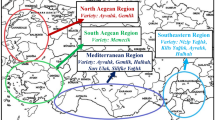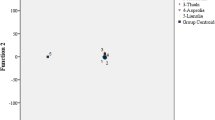Abstract
The fatty acid (FA) composition of 540 Tunisian virgin olive oil hybrids (VOO) were classified by principal component analysis (PCA). Pearson correlation between FA variables revealed an inverse association between C18:1 and C18:2; C18:1 and C16:0, while C16:0 and C16:1 were positively correlated. PCA yielded five significant PCs, which together account for 79.95% of the total variance; with PC1 contributing 36.84% of the total. Eigenvalue analysis revealed that PC1 was mainly attributed to C18:1, monounsaturated fatty acids (MUFA) and the ratios oleic/linoleic (O/L) and monounsaturated fatty acids/polyunsaturated fatty acids (MUFA/PUFA); PC2, by C16:0, saturated fatty acids (SFA) and the palmitic/linoleic ratio (P/L); PC3 by C18:2 and C22:0, PC4 by C18:0 and PC5, by C17:1. Then, PCA analysis indicated that in addition to C16:0, C18:0, C18:1, C17:1, and C22:0, MUFA, SFA and the ratios O/L, P/L and MUFA/PUFA were determined to be the main factors responsible for the olive oil hybrids discrimination.

Similar content being viewed by others
References
Angerosa F, Servili M, Selvaggini R, Taticchi A, Esposto S, Montedoro GF (2004) Volatile compounds in virgin olive oil: occurrence and their relationship with the quality. J Chromatogr A 1054:17–31
Sanchez J, Harwood JL (2002) Biosynthesis of triacylglycerols and volatiles in olives. Eur J Lipid Sci Technol 104:564–573
Psomiadou E, Karakostas KX, Blekas G, Tsimidou MZ, Boskou D (2003) Proposed parameters for monitoring quality of virgin olive oil (Koroneiki cv.). Eur J Lipid Sci Technol 105:403–409
Aparicio R, Roda L, Albi MA, Gutiérrez F (1999) Effect of various compounds on virgin olive oil stability measured by Rancimat. J Agric Food Chem 47:4150–4155
Kandylis P, Vekiari AS, Kanellaki M, Grati Kamoun N, Msallem M, Kourkoutas Y (2011) Comparative study of extra virgin olive oil flavor profile of Koroneiki variety (Olea europaea var microcarpa alba) cultivated in Greece and Tunisia during one period of harvesting. LWT-Food Sci Technol 44:1333–1341
Angiolillo A, Reale S, Pilla F, Baldoni L (2006) Molecular analysis of olive cultivars in the Molise region of Italy. Genet Resour Crop Ev 53:289–295
Pinelli P, Galardi C, Mulinacci N, Vincieri FF, Cimato A, Romani A (2003) Minor polar compound and fatty acid analyses in monocultivar virgin olive oils from Tuscany. Food Chem 80(3):331–336
Aparicio R, Morales MT (1998) Characterization of olive ripeness by green aroma compounds of virgin olive oil. J Agric Food Chem 46(3):1116–1122
Diraman H, Saygi H, Hisil Y (2010) Relationship between geographical origin and fatty acid composition of Turkish virgin olive oils for two harvest years. J Am Oil Chem Soc 87:781–789
Mousa YM, Gerasopoulos D, Metzidakis I, Kiritsakis A (1996) Effect of altitude on fruit and oil quality characteristics of ‘Mastoides’ olives. J Sci Food Agric 71(3):345–350
Gutierrez F, Albi MA, Palma R, Rios JJ, Olias JM (1989) Bitter taste of virgin olive oil: correlation of sensory evaluation and instrumental HPLC analysis. J Food Sci 54(1):68–70
Mariani C, Fedeli E, Grob K, Artho A (1991) Indagine sulle variazioni dei componenti minori liberi ed esterificati di oli ottenuti da olive in funzione della maturazione e dello stoccaggio. Riv Ital Sostanze Gr 68(4):179–186
Stefanoudaki E, Koutsaftakis A, Harwood JL (2011) Influence of malaxation conditions on characteristic qualities of olive oil. Food Chem 127:1481–1486
De Caraffa BV, Gambotti C, Giannettini J, Maury J, Berti L, Gandemer G (2008) Using lipid profiles and genotypes for the characterization of Corsican olive oils. Eur J Lipid Sci Technol 110:40–47
International Olive Council (IOC) (2009) Trade standard applying to olive oil and olive pomace oils. COI/T.15/NC no 3/Rev. 4. Novembre
Dabbou S, Rjiba I, Nakbi A, Gazzah N, Issaoui M, Hammami M (2010) Compositional quality of virgin olive oils from cultivars introduced in Tunisian arid zones in comparison to Chemlali cultivars. Sci Hortic 124:122–127
Dabbou S, Issaoui M, Servili M, Taticchi A, Sifi S, Montedoro GF, Hammami M (2009) Characterisation of virgin olive oils from European olive cultivars introduced in Tunisia. Eur J Lipid Sci Technol 111:392–401
Trigui A, Fiorino P (1995) L’amélioration génétique des variétés d’olivier par croisement: Programme et Résultats Préliminaires du Projet du AGO/COI/FCPB. Olea 23:24
Milatović D, Nikolić D, Đurović D (2010) Variability, heritability and correlations of some factors affecting productivity in peach. Hort Sci (Prague) 37(3):79–87
Dabbou S, Rjiba I, Echbili A, Gazzah N, Mechri B, Hammami M (2010) Effect of controlled crossing on the triglyceride and fatty acid composition of virgin olive oils. Chem Biodivers 7:1801–1813
Matos LC, Cunha SC, Amaral JS, Pereira JA, Andrade PB, Seabra RM, Oliveira BPP (2007) Chemometric characterization of three varietal olive oils (Cvs. Cobrancosa, Madural and Verdeal Transmontana) extracted from olives with different maturation indices. Food Chem 102:406–414
Stefanoudaki E, Kotsifaki F, Koutsaftakis A (1999) Classification of virgin olive oils of the two major Cretan cultivars based on their fatty acid composition. J Am Oil Chem Soc 76:623–626
Ilyasoglu H, Ozcelik B, Van Hoed V, Verhe R (2010) Characterization of Aegean olive oils by their minor compounds. J Am Oil Chem Soc 87:627–636
Arvanitoyannis IS, Vlachos A (2007) Implementation of physicochemical and sensory analysis in conjunction with multivariate analysis towards assessing olive oil authentication/adulteration. Crit Rev Food Sci Nutr 47(5):441–498
Tzouros NE, Arvanitoyannis IS (2001) Agricultural produces: synopsis of employed quality control methods for the authentication of foods and for the classification of foods according to their variety of geographical origin. Crit Rev Food Sci Nutr 41(4):287–319
Allen C, Good P (1971) Acyl lipids in photosynthetic systems. In: Colowic SP, Kaplan NO (eds) Methods in enzymology, vol 23. Academic Press, New York, pp 523–547
EUC (2003) Commission of the European Communities, Commission Regulation EC/1989/03 amending Regulation EEC/2568/91 on the characteristics of olive and olive-pomace oil and on the relevant methods of analysis. Off J Eur Union L295, pp. 57
International Olive Council (IOC) (2001) In COI/T.15/NC no. 2/Rev. 10; COI/T.20/Doc. no. 24
Çam M, Yaşar H, Durmaz G (2009) Classification of eight pomegranate juices based on antioxidant activity measured by four methods. Food Chem 112:721–726
Massart DL, Vandeginste BGM, Deming SN, Michotte Y, Kaufman L (1988) Chemometrices: a textbook. Elsevier, Amsterdam
Sola-Larrañaga C, Navarro-Blasco I (2009) Chemometric analysis of minerals and trace elements in raw cow milk from the community of Navarra, Spain. Food Chem 112:189–196
Bianchi G, Giansante L, Shaw A, Kell DB (2001) Chemometric criteria for the characterisation of Italian protected Denomination of Origin (DOP) olive oils from their metabolic profiles. Eur J Lipid Sci Technol 103:141–150
Kaiser HF (1960) The application of electronic computers to factor analysis. Educ Psychol Meas 20:141–151
León L, De la Rosa R, Gracia A, Barranco D, Rallo L (2008) Fatty acid composition of advanced olive selections obtained by crossbreeding. J Sci Food Agric 88(11):1863–2041
León L, Beltran G, Aguilera MP, Rallo L, Barranco D, De la Rosa R (2011) Oil composition of advanced selections from an olive breeding program. Eur J Lipid Sci Technol 113(7):870–875
Gomez-rico A, Salvador MD, Moriano A, Perez D, Olmedilla N, Ribas F, Fregapane G (2005) Influence of different irrigation strategies in a traditional Cornicabra cv. olive orchard on virgin olive oil composition and quality. Food Chem 2:568–578
Mondal N, Bhat KV, Srivastava PS (2010) Variation in fatty acid composition in Indian germplasm of sesame. J Am Oil Chem Soc 87:1263–1269
Cichelli A, Pertesana GP (2004) High-performance liquid chromatography analysis of chlorophylls, pheophytins and carotenoids in virgin olive oil: chemometric approach to variety classification. J Chromatogr A 1046:141–146
Shin EC, Craft BD, Pegg RB, Phillips RD, Eitenmiller RR (2010) Chemometric approach to fatty acid profiles in runner-type peanut cultivars by principal component analysis (PCA). Food Chem 119:1262–1270
Acknowledgments
This research was supported by a grant from the ‘Ministère de l’Enseignement Supérieur et de la Recherche Scientifique et de la Technologie UR03ES08 “Nutrition Humaine et Désordres Métaboliques” and ‘DGRST-USCR-Spectrométrie de masse. The authors are grateful to Dr A. Trigui, Mr A. Yangui, Mr H. Belguith and Mr I. Chreaif and to the staff of the experimental farms of Taous (Sfax, Tunisia) who contributed to making this research possible.
Author information
Authors and Affiliations
Corresponding author
About this article
Cite this article
Dabbou, S., Chaieb, I., Rjiba, I. et al. Multivariate Data Analysis of Fatty Acid Content in the Classification of Olive Oils Developed Through Controlled Crossbreeding. J Am Oil Chem Soc 89, 667–674 (2012). https://doi.org/10.1007/s11746-011-1946-1
Received:
Revised:
Accepted:
Published:
Issue Date:
DOI: https://doi.org/10.1007/s11746-011-1946-1




